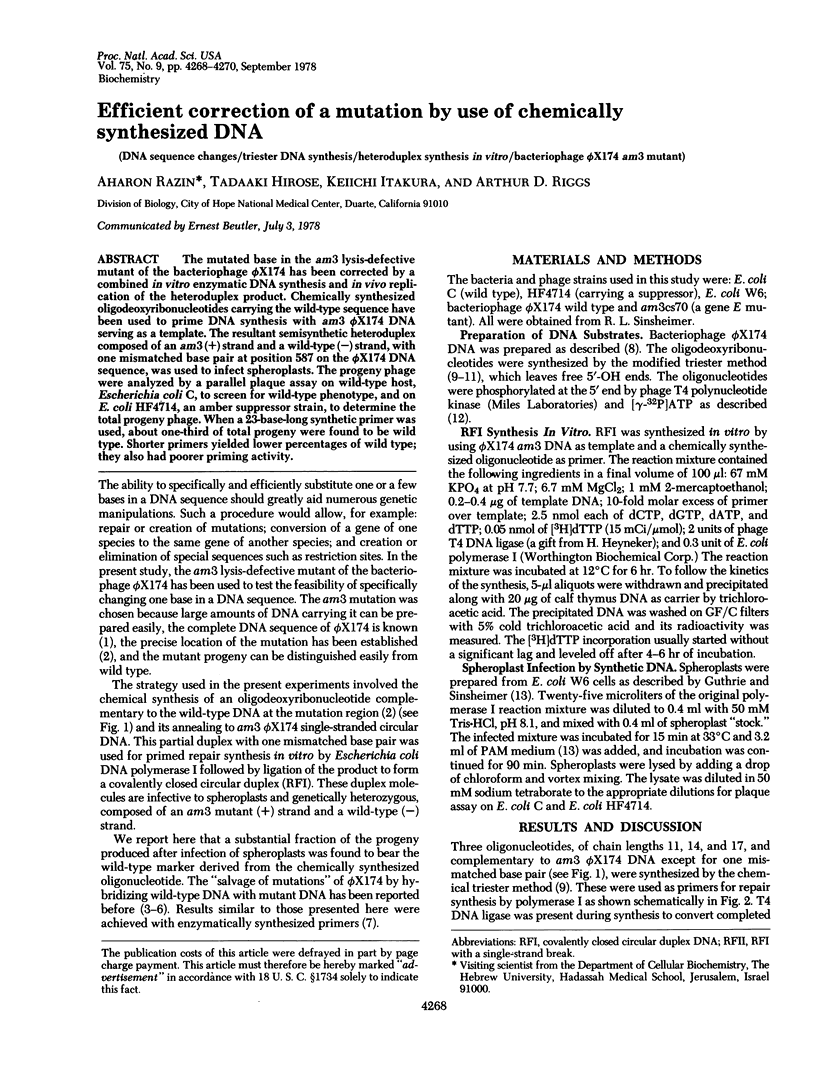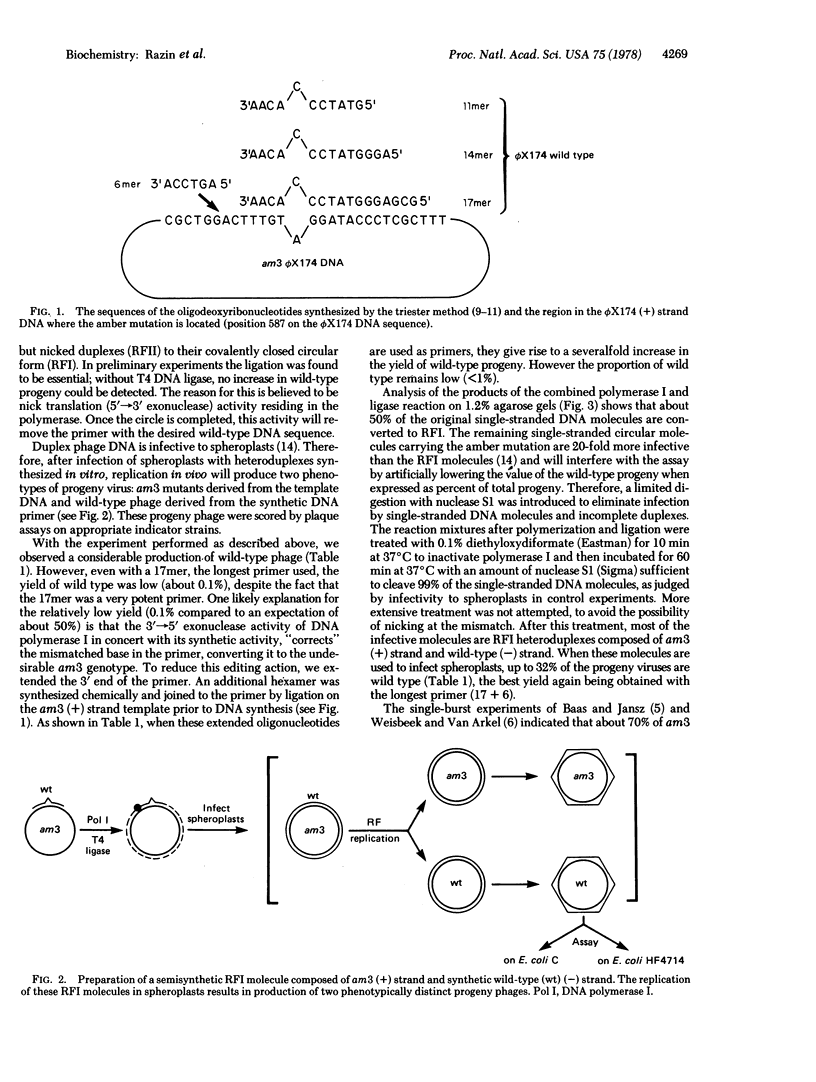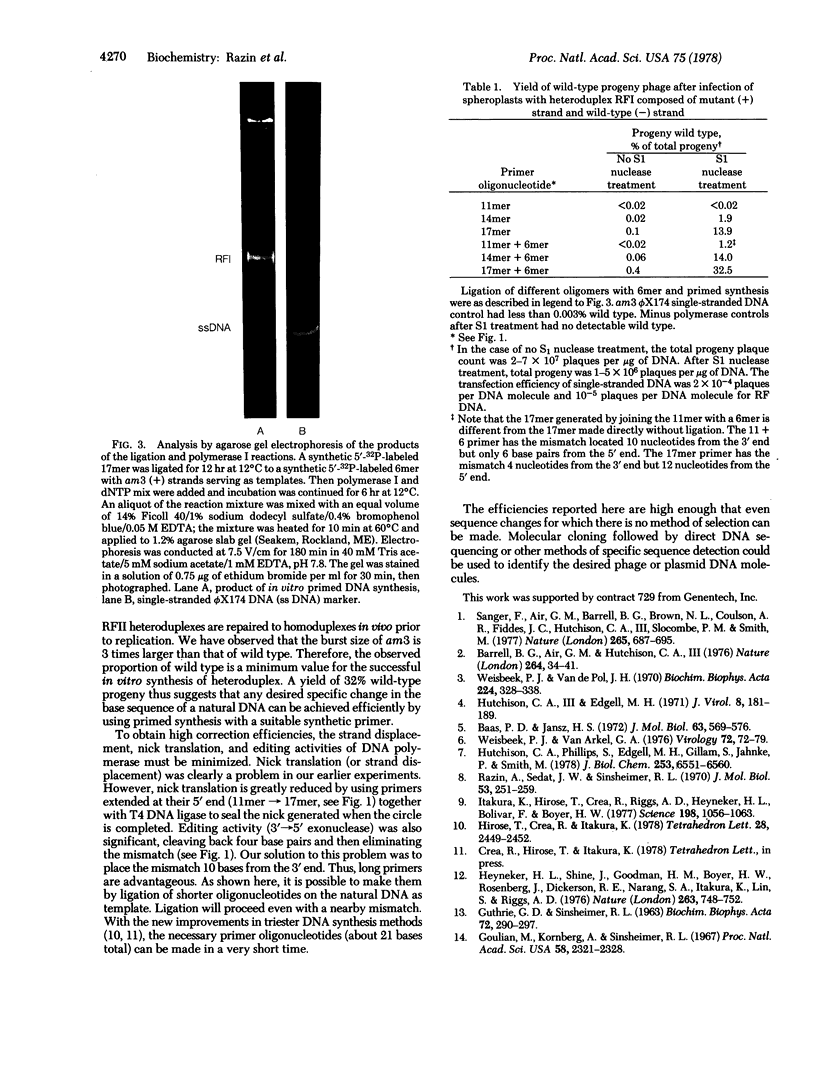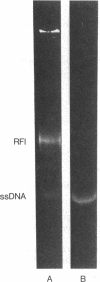Abstract
The mutated base in the am3 lysis-defective mutant of the bacteriophage phiX174 has been corrected by a combined in vitro enzymatic DNA synthesis and in vivo replication of the heteroduplex product. Chemically synthesized oligodeoxyribonucleotides carrying the wild-type sequence have been used to prime DNA synthesis with am3 phiX174 DNA serving as a template. The resultant semisynthetic heteroduplex composed of an am3(+) strand and a wild-type (-) strand, with one mismatched base pair at position 587 on the phiX174 DNA sequence, was used to infect spheroplasts. The progeny phage were analyzed by a parallel plaque assay on wild-type host, Escherichia coli C, to screen for wild-type phenotype, and on E. coli HF4714, an amber suppressor strain, to determine the total progeny phage. When a 23-base-long synthetic primer was used, about one-third of total progeny were found to be wild type. Shorter primers yielded lower percentages of wild type; they also had poorer priming activity.
Full text
PDF


Images in this article
Selected References
These references are in PubMed. This may not be the complete list of references from this article.
- Baas P. D., Jansz H. S. PhiX174 replicative form DNA replication, origin and direction. J Mol Biol. 1972 Feb 14;63(3):569–576. doi: 10.1016/0022-2836(72)90448-2. [DOI] [PubMed] [Google Scholar]
- Barrell B. G., Air G. M., Hutchison C. A., 3rd Overlapping genes in bacteriophage phiX174. Nature. 1976 Nov 4;264(5581):34–41. doi: 10.1038/264034a0. [DOI] [PubMed] [Google Scholar]
- GUTHRIE G. D., SINSHEIMER R. L. Observations on the infection of bacterial protoplasts with the deoxyribonucleic acid of bacteriophage phi X174. Biochim Biophys Acta. 1963 Jun 25;72:290–297. [PubMed] [Google Scholar]
- Goulian M., Kornberg A., Sinsheimer R. L. Enzymatic synthesis of DNA, XXIV. Synthesis of infectious phage phi-X174 DNA. Proc Natl Acad Sci U S A. 1967 Dec;58(6):2321–2328. doi: 10.1073/pnas.58.6.2321. [DOI] [PMC free article] [PubMed] [Google Scholar]
- Heyneker H. L., Shine J., Goodman H. M., Boyer H. W., Rosenberg J., Dickerson R. E., Narang S. A., Itakura K., Lin S., Riggs A. D. Synthetic lac operator DNA is functional in vivo. Nature. 1976 Oct 28;263(5580):748–752. doi: 10.1038/263748a0. [DOI] [PubMed] [Google Scholar]
- Hutchison C. A., 3rd, Edgell M. H. Genetic assay for small fragments of bacteriophage phi X174 deoxyribonucleic acid. J Virol. 1971 Aug;8(2):181–189. doi: 10.1128/jvi.8.2.181-189.1971. [DOI] [PMC free article] [PubMed] [Google Scholar]
- Hutchison C. A., 3rd, Phillips S., Edgell M. H., Gillam S., Jahnke P., Smith M. Mutagenesis at a specific position in a DNA sequence. J Biol Chem. 1978 Sep 25;253(18):6551–6560. [PubMed] [Google Scholar]
- Itakura K., Hirose T., Crea R., Riggs A. D., Heyneker H. L., Bolivar F., Boyer H. W. Expression in Escherichia coli of a chemically synthesized gene for the hormone somatostatin. Science. 1977 Dec 9;198(4321):1056–1063. doi: 10.1126/science.412251. [DOI] [PubMed] [Google Scholar]
- Razin A., Sedat J. W., Sinsheimer R. L. Structure of the DNA of bacteriophage phiX174. VII. Methylation. J Mol Biol. 1970 Oct 28;53(2):251–259. doi: 10.1016/0022-2836(70)90298-6. [DOI] [PubMed] [Google Scholar]
- Sanger F., Air G. M., Barrell B. G., Brown N. L., Coulson A. R., Fiddes C. A., Hutchison C. A., Slocombe P. M., Smith M. Nucleotide sequence of bacteriophage phi X174 DNA. Nature. 1977 Feb 24;265(5596):687–695. doi: 10.1038/265687a0. [DOI] [PubMed] [Google Scholar]
- Weisbeek P. J., Van Arkel G. A. On the origin of bacteriophage phiX174 replicative form DNA replication. Virology. 1976 Jul 1;72(1):72–79. doi: 10.1016/0042-6822(76)90312-3. [DOI] [PubMed] [Google Scholar]
- Weisbeek P. J., van de Pol J. H. Bological activity of phi X174 replicative form DNA fragments. Biochim Biophys Acta. 1970 Dec 14;224(2):328–338. [PubMed] [Google Scholar]



